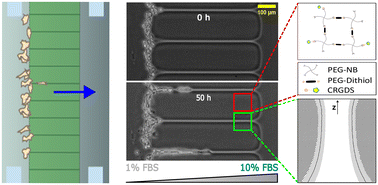Photolithographic microfabrication of hydrogel clefts for cell invasion studies†
Abstract
Invasion of migrating cells into surrounding tissue plays a key role in cancer metastasis and immune response. In order to assess invasiveness, most in vitro invasion assays measure the degree to which cells migrate between microchambers that provide a chemoattractant gradient across a polymeric membrane with defined pores. However, in real tissue cells experience soft, mechanically deformable microenvironments. Here we introduce RGD-functionalized hydrogel structures that present pressurized clefts for invasive migration of cells between reservoirs maintaining a chemotactic gradient. Using UV-photolithography, equally spaced blocks of polyethylene glycol-norbornene (PEG-NB) hydrogels are formed, which subsequently swell and close the interjacent gaps. The swelling ratio and final contours of the hydrogel blocks were determined using confocal microscopy confirming a swelling induced closure of the structures. The velocity profile of cancer cells transmigrating through the clefts, which we name ‘sponge clamp’, is found to depend on the elastic modulus as well as the gap size between the swollen blocks. The ‘sponge clamp’ discriminates the invasiveness of two distinct cell lines, MDA-MB-231 and HT-1080. The approach provides soft 3D-microstructures mimicking invasion conditions in extracellular matrix.



 Please wait while we load your content...
Please wait while we load your content...